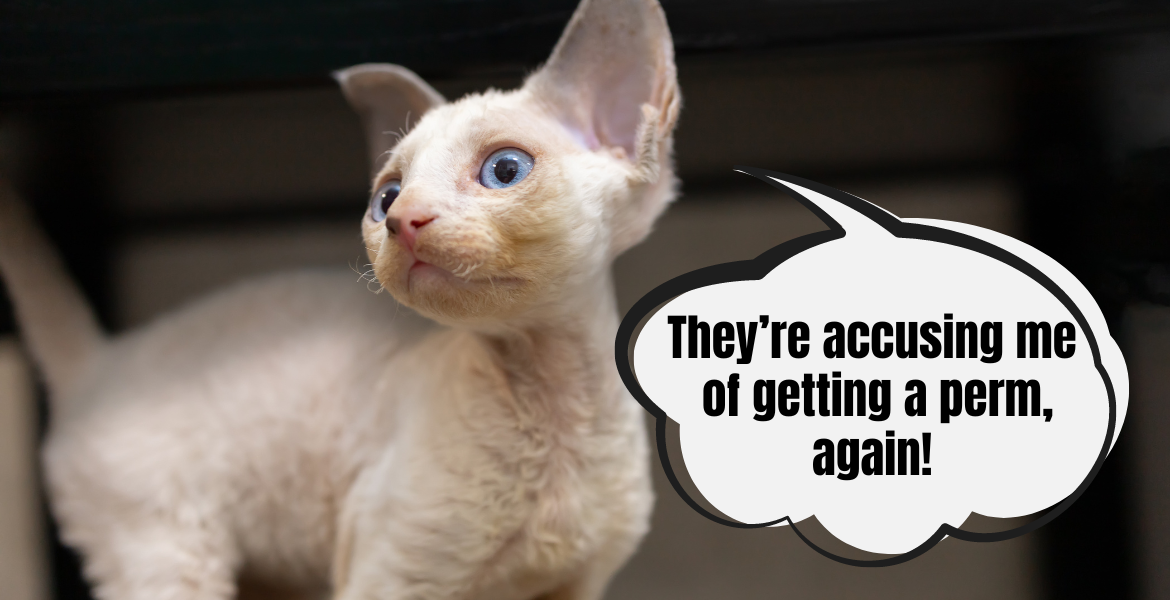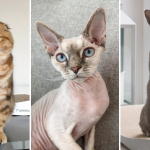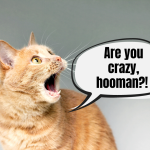Mother Nature can be surprising, occasionally endowing animals with unusual looks. Even cat fur doesn’t escape these rules – from fluffy, long-haired beauties to almost completely naked cats, the variety in hairstyles is hard to deny among our furry friends. At myKotty, we love delving into cat curiosities and getting to know the feline world even better. That’s why today, together with you, we’re taking a closer look at one of the most interesting varieties of cat fur: curly locks. Which breeds can boast them, and does this type of fur require special care? Come with us, fabCat – let’s find out.
Cat with curls? It’s not a trendy hairstyle, it’s pure genetics
The density, structure, and length of cat fur are determined, of course, by genetics. The environment in which our domestic furry ancestors lived significantly influenced how a cat’s body adapted to those temperatures. If a kitty had to survive in the frosty climates of Siberia or northern America, it’s clear that it evolved a lush coat to make the cold more bearable. These same adaptive needs also influenced the presence of fur in cats’ ears, the size of their paws, or the overall size of their bodies. Although today our pets don’t require such specialized adaptations, we see traces of their ancestors in all breeds.
Given the above, is curly fur in cats also a form of environmental adaptation? Not necessarily – just like different fur colors, curly hair in cats appeared as a result of various genetic mutations, passed through successive feline generations, until it eventually became a characteristic feature of certain breeds. Today, among the most popular representatives of curly-haired cats are breeds such as the Selkirk Rex, Devon Rex, Cornish Rex, and LaPerm, although more or less curly coats may also appear in other (especially long-haired) cats. Depending on the breed, the fur may form beautiful, delicate waves or completely curl up, occurring in short and long hair variants, with an undercoat or without. As you can see, even in such a narrow group of cats with a specific appearance trait, we can’t complain about a lack of diversity.
Selkirk Rex – curly-haired fluffball among cats
The first owner of curly, lamb-like fur we’ll meet today is the Selkirk Rex breed. Although this is a relatively young breed, interest in it is constantly growing, partly due to the unique appearance of these beautiful cats. Thanks to their fluffy curls, representatives of the breed resemble miniature, purring sheep with wonderful personalities, rather than typical, dignified sofa tigers. Just look at this teddy bear!
The Selkirk Rex breed originated from crossing Persian cats with typical domestic, non-pedigree cats, one of which was unexpectedly born with curly fur. Since kittens with unusual curly coats were born from the cross, their breeding continued, incorporating British, exotic, and Persian cats into the breed as well. Selkirks are healthy cats with an incredibly gentle disposition typical of a typical lap cat, although there may be some diversity, depending on which cat breeds were involved in creating a specific breeding line. The fur of Selkirk Rex cats is soft, plushy, and dense, occurring in almost all color variations and both long and short hair options. An interesting feature of Selkirk Rex cats is their whiskers, which also curl, but due to their tendency to break, they are often shorter than classic cat whiskers.
Devon Rex – a cat elf with curly hair
This breed probably doesn’t need an introduction – Devon Rex cats are becoming increasingly popular every year, thanks to their unusual appearance and fantastic character. Compared to sprites, elves, and even aliens, Devon Rex cats are incredibly sociable, active, and lively, while also being strongly attached to their humans. And Cat Guardians appreciate that because unlike many couch potatoes, with a Devon Rex by your side, you’ll never get bored.
What about their curly fur? Unlike Selkirks, here we’re talking more about waves than lush locks and very short hair, the density of which may depend on the location of the cat’s body, the season, age, and of course, health. Nevertheless, it’s incredibly soft and fluffy fur – if you have the opportunity, it’s worth giving such a kitty a pet.
Cornish Rex – an athlete in curly attire
Our final guests today are the Cornish Rex cats. This is another breed originating from Great Britain, in which curly fur is an important distinguishing feature, although, interestingly, Cornish Rex cats are not related to Devons. The fur waves of these cats remind us of hairstyles straight from old Hollywood – they’re delicate, elegant, and perfectly styled. Simply classy! Interestingly, Cornish Rex fur consists only of transitional hairs – their fur is dense and soft, but it doesn’t provide enough protection against low temperatures, so these cats cling to blankets and radiators like moths to a flame in winter.
What can you expect from Cornish Rex cats in terms of character? Like Devons, they are energetic, active, athletic cats that don’t like to be bored. They are also exceptionally intelligent creatures – they eagerly learn tricks, can master the art of opening doors and drawers, love interactive toys, and adore it when they have your full attention. They will thrive in a family environment, including with children – after all, the more attention, the better.
How to care for curly fur?
The answer depends, of course, on whether we’re talking about Selkirks with long hair or maybe Devons or Cornish Rexes, whose fur is much shorter. In the case of the former, regular brushing will be necessary to prevent matting – this rule applies to all long-haired breeds, by the way. In the case of short-haired cats, like Devons and Cornish Rexes, whose fur is really short, cats usually manage their grooming themselves. From time to time, it may be necessary to brush their fur with a soft brush or wipe the areas that get the oiliest, but overall, and in contrast to typical long-haired breeds, cats with curly fur are relatively low-maintenance. When choosing a specific breed, always ask the breeder for help – as a specialist working with cats every day, they will surely provide you with the best tips and tricks regarding the care and hygiene of your feline friend.
What breed of cats would you like to learn about in future articles, fabCats? We’ll gladly prepare more materials of this type for you and delve into the curiosities hidden under cat fur 🙂




